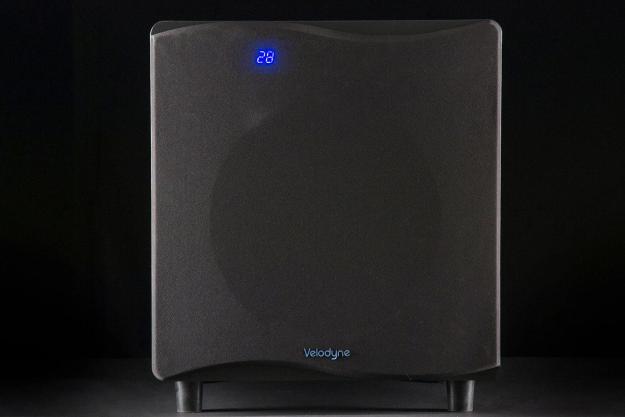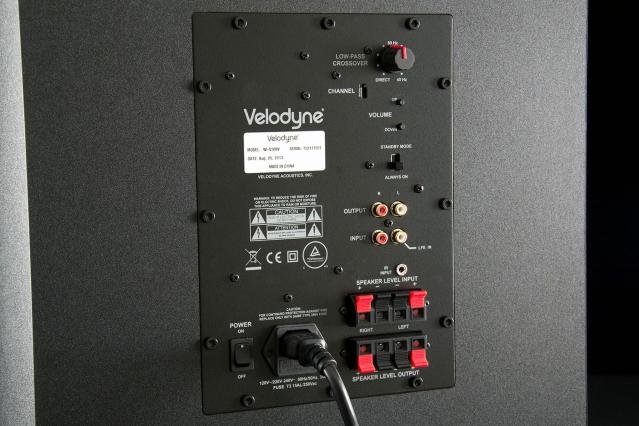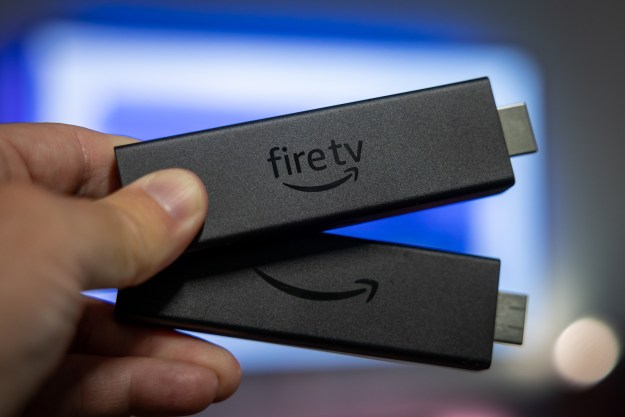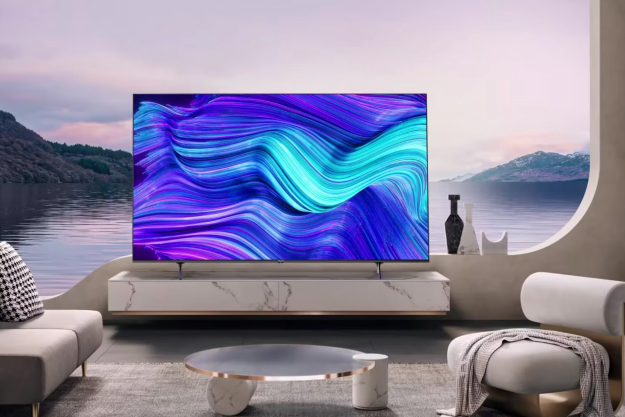
“With wireless transmission and an automatic EQ built right in, Velodyne’s Wi-Q brings the boom without much time crawling around on the floor, even if its brains can’t quite compensate for poor placement.”
- Solid wireless signal delivery
- Best-in-class feature set
- Punchy, with deep extension
- Lyrical and nimble
- Auto-EQ seems ineffective
- No floor spikes included
- Not so attractive with grill off
There is perhaps no audio component more frustrating than the subwoofer, which always comes packed with as many asterisks as promises.
You can place it anywhere! Sorry, where a sub gets placed will make or break how good it sounds. Oooh, but you can hide it in a corner! Actually: Placed too close to a wall, some subs will make an annoying chuffing sound. Seriously, though, a sub will blend right in with your speakers, and you’ll never be able to pick it out. Yeah, not really … if it’s too close to your seat it can be a constant distraction.
Sure, we’re dramatizing a bit — subwoofers aren’t really evil, spiteful creatures … it just feels that way. Misinformation is to blame for setting us up with unreal expectations about subs. But physics confirm what many us have learned the hard way: Low frequencies are a tricky son-of-a-gun.
The Wi-Q can be integrated into nearly any audio system, old or new.
Velodyne’s Wi-Q subwoofer aims to take some of the trickery out of the experience in two ways: wireless signal transmission, and built-in automatic EQ. The idea is that the wireless signal allows the sub to be placed anywhere an outlet is near, while the auto-EQ aims to make sure the sub sounds good where you sit.
The bad news is this: We’ve had bad luck with these kinds of EQ programs, and the Wi-Q didn’t break that streak. But the good news is that the sub is still worth a serious look anyway, because it does a lot right where others go wrong.
Hands on video
Out of the box
The Wi-Q subwoofer is available in 10- and 12-inch sizes – we received the 10-inch model for review. For a subwoofer that measures 17.31 x 15.25 x 17-inches (with feet and grill attached) we felt its 37-lb. weight was a little on the low side, especially considering Velodyne’s reputation for building tank-like subwoofers. We also weren’t especially impressed with the results of our “knock test,” which failed to produce the dead thunk we had hoped for, instead giving away the sub’s less-than-totally-rigid cabinet construction, which also failed to bite back at our knuckles. In comparison, the similarly priced Pioneer Elite SW-E10 subwoofer designed by Andrew Jones is more compact and has a more inert feel to it.
The Wi-Q’s Black Ash vinyl finish won’t win any design awards, but it is by no means an eyesore, and it should hold up well over years of use. We like the slight swoop Velodyne gave to this sub’s grill, but since we tend to prefer leaving the grill off entirely, we wish the grille’s security knobs were less conspicuous.
In the box with the subwoofer we found a wireless transmitter, card-style remote control, tiny microphone stand, power cable, and power adapter. No floor spikes were provided, as the Wi-Q sub has thick rubber feet.
Features and design
For a relatively inexpensive sub, the Wi-Q sports a wide array of features. Starting on the back of the sub, the Wi-Q’s inclusion of speaker-level inputs and outputs is virtually unheard of these days. Slightly less surprising, but equally appreciated, are the inclusion of stereo RCA outputs set alongside the RCA inputs. With all these options available, the Wi-Q can be integrated into nearly any audio system, old or new.
The Wi-Q sub’s performance never hints at cut corners.
The sub’s amp features a continuously adjustable phase dial, but uses two control buttons rather than an analog dial for volume control. This allows the sub to offer precise volume control with graphic feedback thanks to the sub’s blue LCD display window placed up front.
That blue LCD display also offers feedback information for a variety of settings adjustable via the supplied remote control. The system offers four EQ presets – Movies, Rock, Jazz, and Games – which can’t be customized by the user. Phase control is also handled using the remote control, with 90-degree steps. A night mode implements dynamic compression, while a mute switch offers a quick-and-dirty way to defeat the sub entirely. When the display isn’t needed, it can be turned off using the supplied remote.
One of the sub’s most useful features, however, is one that you can’t see: Velodyne has implemented a digital limiter system that keeps the subwoofer from moving into distortion territory, and we’re here to tell you that it works really well. Over the course of our testing, we pushed on the Wi-Q hard, but we never managed to make it sound dirty.

If forced to gripe about the sub’s design, we’d home in on the use of a foam surround on the driver. The foam surround may make for a less expensive option, and even have some acoustical benefits, but in the end, it will decompose earlier than, say, a rubber surround. In fact, our inner geek would prefer to have seen a more rigid driver material in general, but as we’ll soon discuss, the Wi-Q sub’s performance never hints at cut corners.
The setup
For most, setting up the Wi-Q subwoofer should be a brief affair. The provided wireless transmitter can be connected to an AV receiver’s subwoofer output using an RCA cable. When both the sub and transmitter are powered up, they should pair automatically. Velodyne claims their system is capable of up to 50 feet of transmission, but we wouldn’t recommend pushing much past 40 feet.
Figuring out where to place the subwoofer, however, is no easier than it has ever been, despite Velodyne’s attempt to make it so with a built-in auto-EQ system. We placed the subwoofer in a location where we knew we’d get a fair amount of “suckout” between 80Hz and 40Hz, then challenged the subwoofer to make an audible difference with its auto EQ.
We pushed on the Wi-Q hard, but we never managed to make it sound dirty.
Starting the EQ system is as simple as plugging the provided microphone into an input jack on the front of the sub (another reason not to leave the grill off), positioning the mic on its stand at the listening position, and pressing the EQ button on the supplied remote.
The sub will then run through a series of frequency sweeps several times over before storing its results. At this point, the subwoofer should have adjusted its EQ to provide the best possible sound at the listening position. Unfortunately, we heard no difference at all.
To be clear, we weren’t expecting miracles here. We just wanted to hear a little more of the gap we had in the bass to be filled in. Even just a little bit would have been a welcome change, but not hearing any difference at all was a bit of a let-down. We moved the sub several times and repeated our A/B comparison, with no change in results.

In the end, to get the best sounding bass, we had to experiment with sub placement, ultimately turning to the “subwoofer crawl” in order to confirm our findings. You can learn more about subwoofer placement here, but for us, the ideal position wound up being right against the front wall, roughly one third of the way into the room, and directly behind the left front speaker.
From then on, the Wi-Q subwoofer did an excellent job of showing us what it was capable of, and it turns out, it is capable of a whole lot.
Performance
Our subwoofer tests always begin with music because music is usually familiar and easy for the ear to follow – this also gives us a chance to evaluate how tonally accurate a subwoofer is.
We began by listening to Dire Straits’ Brothers in Arms album, first in stereo, then again using the supplied 5.1 audio track. At first, we were a little underwhelmed. In stereo mode, we felt like the Wi-Q was doing an OK job with the bass information it was receiving, it just didn’t seem like it was getting much information to work with, even though everything below 80Hz was being sent its way. But then we switched to the surround mix, and the Wi-Q sprang to life.
The subwoofer sounded so good, we ended up listening to the entire album twice.
The subwoofer sounded so good, we ended up listening to the entire album twice. It had been a while since we had a good sit-down listen to this record, and the Wi-Q made the experience all the more enticing. The album tends to make swift shifts between pounding, raucous bass and subtle, lyrical lines that flow in and out, which can be a challenge for subs of lesser designs. The Wi-Q, however, proved it was nimble enough to weave a delicate musical Web one moment, then sucker-punch you in the chest the next. An excellent example of this came with “Ride Across the River,” where in the reggae-like bass pattern trades with poignant punches of kick drum – the Wi-Q darted back and forth between both with ease.
More than satisfied with the Wi-Q’s musicality, we shifted to movie watching in an effort to gauge the sub’s ability to morph in to sonic sledgehammer of brute force — turns out, it pulls off that transition pretty well, too.
There is perhaps no better way to punish a subwoofer than by subjecting it to the merciless onslaught of low-frequency lawlessness that is a Michael Bay Transformers movie. Seriously, pick any of them, grab a chapter at random, and we can assure you your sub will be rumbling in no time. Fortunately, the Wi-Q doesn’t discriminate the tasteless from the tasteful when it comes to soundtracks, and it hung in there just fine. Still, we thought we could do better. And it turns out, one of the more impressive demonstrations came from a short clip in Skyfall, wherein Bond’s adversary blows a hole in the side of a tunnel before unleashing a crashing train on him. In this scene, there is some seriously deep, rumble-your-seat kind of bass that you tend to feel deep inside you, and the Wi-Q dropped right down and delivered that visceral experience with conviction and consistency – if the sub was ever about to run out of gas, it never hinted at it.
Of course, as good as the Wi-Q is for its price range, it can’t quite match up to Velodyne’s own premium subs, or those from competitors such as Paradigm or SVS. The SVS SB-13 Ultra, for instance (still one of our all-time favorite subs) is a sealed design with enough power and control that it can start and stop a bit faster than the Wi-Q, which exhibited an expected amount of overhang and tended to have a slightly thumpier appeal overall.
Conclusion
Velodyne’s Wi-Q are an excellent example of what years of experience and expertise can bring to the value subwoofer proposition. You can spend a little less, but you’ll get far, far less quality. And you can spend more, but the Wi-Q tests the law of diminishing returns so well, you’re not going to get exponentially better results – the improvements are more subtle.
Does the Wi-Q stand alone? No. The Paradigm Monitor Sub 8 is far more compact, and just as potent, through it doesn’t reach quite as deep. The SVS SB-2000 goes even deeper, and maintains a light, poignant touch at all times. But neither of these subwoofers offer fully functioning wireless signal delivery right out of the box, nor do they offer the sort of convenience features that the Velodyne Wi-Q does, making it a particularly enticing option for those looking for the best balance between sound quality, features and price-point.
Highs:
- Solid wireless signal delivery
- Best-in-class feature set
- Punchy, with deep extension
- Lyrical and nimble
Lows:
- Auto-EQ seems ineffective
- No floor spikes included
- Not so attractive with grill off










